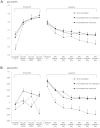Colonization and local host response following intramammary Staphylococcus chromogenes challenge in dry cows
- PMID: 34711282
- PMCID: PMC8554945
- DOI: 10.1186/s13567-021-01007-8
Colonization and local host response following intramammary Staphylococcus chromogenes challenge in dry cows
Abstract
Although extensive research has been performed on bovine non-aureus staphylococci (NAS), several aspects such as bacteria-host interaction remain largely unstudied. Moreover, only a few mastitis pathogen challenge studies in cows have been conducted in the dry period, an important period that allows intramammary infection (IMI) to cure and new IMI to occur. We challenged 16 quarters of 4 Holstein Friesian cows at dry off with 100; 100 000 or 10 000 000 CFU of the udder-adapted S. chromogenes IM strain. Four quarters from one cow served as negative controls. Internally sealed quarters remained untouched, whereas non-sealed quarters were sampled 3 times during the dry period. After parturition, colostrum and daily milk samples were taken during the first week of lactation of all quarters. In total, 8 quarters appeared to be colonized, since S. chromogenes IM was recovered at least once during the experiment, as substantiated using Multilocus Sequence Typing. S. chromogenes IM shedding was highest in dry quarters inoculated with 10 000 000 CFU. Colonized quarters had the highest quarter somatic cell count (qSCC) in early lactation. Inoculated quarters (both colonized and non-colonized) had lower IL-6 and IL-10 concentrations in the dry period, whilst IFN-γ levels tended to be higher in colonized quarters compared to non-inoculated quarters. Also, IgG2 levels were higher in inoculated compared to non-inoculated quarters and the IgG2/IgG1 ratio was on average above 1. To conclude, we showed that dry quarters can be colonized with S. chromogenes IM, resulting in a shift towards a Th1 response in late gestation and early lactation characterised by an increased IgG2 concentration. However, further research is needed to confirm our findings.
Keywords: Dry period; IFN-γ; IL-10; IL-6; IgG1; IgG2; Staphylococcus chromogenes; intramammary challenge; non-aureus staphylococci.
© 2021. The Author(s).
Conflict of interest statement
The authors declare that they have no competing interests.
Figures






Similar articles
-
Longitudinal study on the effects of intramammary infection with non-aureus staphylococci on udder health and milk production in dairy heifers.J Dairy Sci. 2021 Jan;104(1):899-914. doi: 10.3168/jds.2020-18685. Epub 2020 Nov 12. J Dairy Sci. 2021. PMID: 33189263
-
The effect of intramammary infection in early lactation with non-aureus staphylococci in general and Staphylococcus chromogenes specifically on quarter milk somatic cell count and quarter milk yield.J Dairy Sci. 2020 Jan;103(1):768-782. doi: 10.3168/jds.2019-16818. Epub 2019 Oct 31. J Dairy Sci. 2020. PMID: 31677845
-
Distribution of non-aureus staphylococci from quarter milk, teat apices, and rectal feces of dairy cows, and their virulence potential.J Dairy Sci. 2020 Nov;103(11):10658-10675. doi: 10.3168/jds.2020-18265. Epub 2020 Sep 10. J Dairy Sci. 2020. PMID: 32921446
-
Local host response following an intramammary challenge with Staphylococcus fleurettii and different strains of Staphylococcus chromogenes in dairy heifers.Vet Res. 2016 May 12;47(1):56. doi: 10.1186/s13567-016-0338-9. Vet Res. 2016. PMID: 27176792 Free PMC article.
-
Differential immune response to two Staphylococcus aureus strains with distinct adaptation genotypes after experimental intramammary infection of dairy cows.Microb Pathog. 2022 Nov;172:105789. doi: 10.1016/j.micpath.2022.105789. Epub 2022 Sep 20. Microb Pathog. 2022. PMID: 36176246
Cited by
-
Phenotypic and genotypic assessment of iron acquisition in diverse bovine-associated non-aureus staphylococcal strains.Vet Res. 2024 Jan 12;55(1):6. doi: 10.1186/s13567-023-01260-z. Vet Res. 2024. PMID: 38217046 Free PMC article.
-
Exploring the distinct immunological reactions of bovine neutrophils towards major and minor pathogens responsible for mastitis.Int J Vet Sci Med. 2023 Oct 11;11(1):106-120. doi: 10.1080/23144599.2023.2262250. eCollection 2023. Int J Vet Sci Med. 2023. PMID: 37841527 Free PMC article.
-
Non-aureus staphylococci and mammaliicocci as a cause of mastitis in domestic ruminants: current knowledge, advances, biomedical applications, and future perspectives - a systematic review.Vet Res Commun. 2023 Sep;47(3):1067-1084. doi: 10.1007/s11259-023-10090-5. Epub 2023 Mar 25. Vet Res Commun. 2023. PMID: 36964436 Free PMC article.
-
Priming of the murine mammary gland with Staphylococcus chromogenes IM reduces bacterial growth of Streptococcus uberis: a proof-of-concept study.Vet Res. 2023 Mar 27;54(1):28. doi: 10.1186/s13567-023-01156-y. Vet Res. 2023. PMID: 36973819 Free PMC article.
-
Staphylococcal mastitis in dairy cows.Front Vet Sci. 2024 May 28;11:1356259. doi: 10.3389/fvets.2024.1356259. eCollection 2024. Front Vet Sci. 2024. PMID: 38863450 Free PMC article. Review.
References
-
- Piepers S, De Meulemeester L, de Kruif A, Opsomer G, Barkema HW, De Vliegher S. Prevalence and distribution of mastitis pathogens in subclinically infected dairy cows in Flanders, Belgium. J Dairy Res. 2007;74:478–483. - PubMed
-
- Pyörälä S, Taponen S. Coagulase-negative staphylococci—emerging mastitis pathogens. Vet Microbiol. 2009;134:3–8. - PubMed
-
- Schukken YH, González RN, Tikofsky LL, Schulte HF, Santisteban CG, Welcome FL, Bennett GJ, Zurakowski MJ, Zadoks RN. CNS mastitis: nothing to worry about? Vet Microbiol. 2009;134:9–14. - PubMed
-
- Tenhagen BA, Köster G, Wallmann J, Heuwieser W. Prevalence of mastitis pathogens and their resistance against antimicrobial agents in dairy cows in Brandenburg, Germany. J Dairy Sci. 2006;89:2542–2551. - PubMed
-
- Wuytack A, De Visscher A, Piepers S, Boyen F, Haesebrouck F, De Vliegher S. Distribution of non-aureus staphylococci from quarter milk, teat apices, and rectal feces of dairy cows, and their virulence potential. J Dairy Sci. 2020;103:10658–10675. - PubMed
MeSH terms
Supplementary concepts
Grants and funding
LinkOut - more resources
Full Text Sources
Medical

